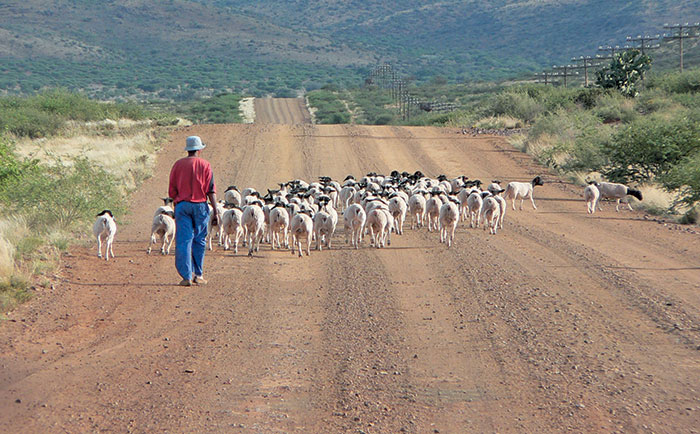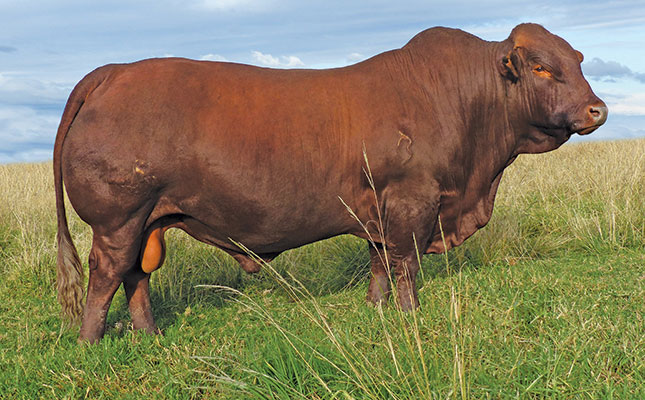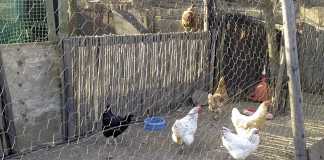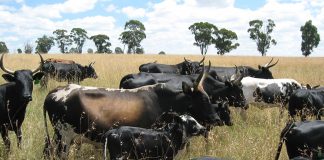
Photo: Chris Nel
Do the right thing at the right time. Keep it simple, straightforward and practical. Never take shortcuts. And get the best professional input when necessary.
This sums up the herd health management approach of Piet Wolmarans of Millvale Farm near Moedwil on the N4 West between Rustenburg and Swartruggens in North West.
Piet’s Kwantum Simmentaler stud herd has made its mark on the breed nationally and internationally with bulls such Kwantum Profeet KM 95 13, Kwantum Doorsie KM 03 63 and Kwantum Migkar KM 94 18, as well as cows such as Kwantum Meisie KM 07 66 and Kwantum Absi KM 05 22.
Due to the size of the farm, the Kwantum herd is not large. It averages around 150 cows at any time, run on 700ha.
In addition to the Simmentalers, Piet runs a flock of 160 Dorper-type commercial mutton sheep that has a lambing rate of 145%.
The farm’s grazing resources consist of 640ha veld and dryland pasture that is irrigated as needed, as well as crop stover. The vegetation type is Acocks Veld Type 18 (Mixed Bushveld) with elements of Acocks veld Type 13 (Other Turf Thornveld).
The long-term annual rainfall is between 500mm and 550mm. Water comes mainly from a borehole. (In the recent drought, the groundwater level dropped appreciably.)
Prevention is the key
Healthy and productive livestock are a priority for Piet, whether the animals are valuable genetic prototypes or commercial cattle for beef production.
“Preventing disease and parasite infection is obviously better than treating it once it has gained a foothold,” he stresses. To this end, he suggests the following:
- Use the correct vaccine to prevent a specific disease or strain. Moreover, administer it at the correct time (season; and time of day, if applicable).
- Store all inactivated vaccine in a refrigerator at between 2°C and 8°C. Ideally, the average should be 5°C. The vaccine should be kept cold, using a vacuum flask, insulated container or cool bricks, during transporting and final use.
- Use the vaccine well before the expiry date. Destroy expired vaccine to prevent it from being used accidentally. Unused vaccine should not be kept for future use; rather obtain a new batch.
- Use a new or sterilised needle for each animal to prevent cross-infection.
- Keep meticulous records of all vaccinations, including place, date and time, vaccine name, batch number and expiry date, animal ID number (where applicable), and name of vaccinator and assistants.
- Keep the empty containers for record purposes and future reference for as long as necessary.
In terms of the animals, Piet has the following advice:
- Train all stockmen to handle animals properly, but don’t over-delegate responsibility. In the final analysis, it’s up to you as the farmer to take care of your animals.
- Ensure that each animal due to be vaccinated is ready for the procedure. Check the age, health status, nutrition level and body temperature as recorded on a rectal thermometer. An animal must be healthy when it is vaccinated, as some vaccines can have a negative effect on an animal suffering from a different disease. Read the instructions, and if in doubt, consult a vet.
- Ensure that the animals are calm and unstressed. Abnormal activity, such as being chased and rounded up, will temporarily increase the body temperature. Allow the animals to rest in the shade until their metabolism and body temperature return to normal.
- In terms of national animal health legislation, some diseases are notifiable and can be treated by a state vet at no cost to the farmer. In addition, the vaccine for some diseases is free. Check with your local state vet.
- Draft an inoculation programme for the full year, and stick to it. Anticipate what might happen in a worst-case scenario during the change of the seasons and plan ahead.
Livestock diseases prevalent in the Moedwil area, where Piet’s farm is situated include:
- Bovine viral diarrhoea (BVD or snotsiekte): This is transmitted to cattle by blue wildebeest introduced by owners of neighbouring farms.
- Heartwater: “This is prime heartwater country,” says Piet, adding that 17 of the 21 strains of the disease found in South Africa have been identified here. Piet bought the farm in 1982. “Before that, it belonged to three cattle speculators,” he recalls wryly. “Hence the proliferation of heartwater strains.”
- Blackleg (sponssiekte): The bacterium Clostridium chauvoei forms resistant spores, which survive in dung, soil and livestock kraals. These infect animals through wounds incurred during shearing, castration and tail docking, as well as bites and cuts. Unhygienic conditions and dirty, infected handling equipment contribute to the transmission of the disease.
- Anthrax (miltsiekte): Caused by Bacillus anthracis, this is a highly infectious fatal disease in mammals and humans. Most outbreaks occur in areas where animals have previously died of anthrax; the spores remain viable in the environment for decades.
A bovine infected with anthrax can die within hours and is typically found with a bloody discharge from the body openings. The carcass decomposes rapidly. - Botulism (lamsiekte): This is caused by the bacterium Clostridium botulinum. Onset is rapid and usually fatal due to the toxin the bacterium produces. Typical signs include hind leg weakness, paralysis, collapse and death. Common sources of the toxin include animal carcasses, rotting organic material and poor silage. Treatment is seldom successful.
Fortunately, the combination vaccine Supavax makes protecting cattle and sheep against blackleg, anthrax and botulism relatively simple and effective.
Sexually transmitted diseases
Before the start of the breeding season, Piet sheath-washes all bulls against Trichomonas and Chlamydia. He vaccinates heifers at six to seven months – before they become sexually mature – against contagious abortion (CA).
This also serves to prevent the possible variable performance of animals in the herd being viewed with suspicion.
“A farmer must ensure that every animal he brings onto his farm is free of CA, Trichomonas and Chlamydia, because this is how these diseases are spread and established. Insist on a certificate confirming this,” he says.
CA is a life-threatening disease for humans. By law, an animal that tests positive
for CA must be branded immediately and destroyed. “This is the only way to finally extinguish the CA flame,” says Piet.
As an essential free service, the state vet tests the entire Kwantum herd for CA twice a year and issues a certificate for every animal tested CA-positive. These animals are transported separately in a quarantined truck and immediately slaughtered as prescribed at an authorised abattoir.
The meat is unsuitable for human consumption, but when processed it can be used for other purposes such as dog food.
“Don’t stint on Rift Valley fever inoculations,” warns Piet. “The price of an inoculation is 2% of the value of the animal it can save.
“Also, don’t short-change on BVD vaccine. The Leucoplas 3 vaccine costs less than the animal it saves. Slaughter every animal that tests positive for BVD. In any case, it would grow slowly and yield less meat, but the meat is still safe for human consumption.”
Piet tests rams regularly for brucellosis, with the help of Dr Marli Olivier, the state vet in Swartruggens. As she does not do sheath washing, this is for Piet’s own account.
Staff hygiene
Personal hygiene is crucial for stockmen and assistants. “I provide proper ablution
and washing facilities with clean hot and cold water, but still have staff tested regularly for possible zoonotic diseases,” Piet explains.
It’s the details that count
He again emphasises the need to keep written records of all inoculations and treatment for every animal. “As the saying goes, ‘The bluntest pencil is sharper than the sharpest memory’.”
Thoroughness, he stresses, is all-important. A farmer should follow the instructions of the vaccine manufacturer, and test a bull for fertility within six weeks before using it.
“This test should include a clinical examination and fertility test by a vet,” he adds.
Piet’s records show that, in a commercial beef herd, carrying a non-pregnant cow can cost R22,90/day on lost production, given that a 220kg weaner sells for R38/kg liveweight (R8 360 divided by 365 days equals R22,90/day).
Phone Piet Wolmarans on 083 291 0073, or email him at [email protected].












